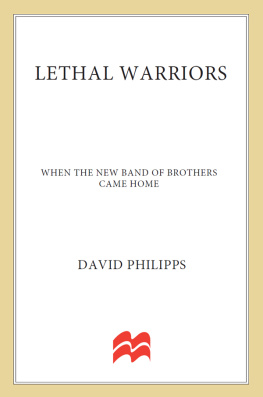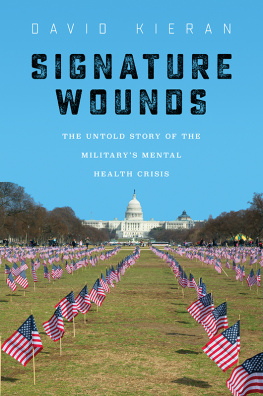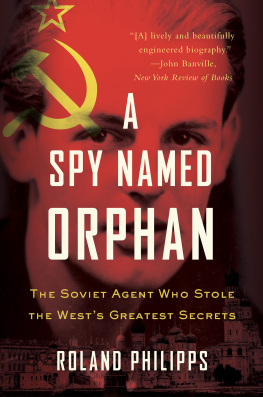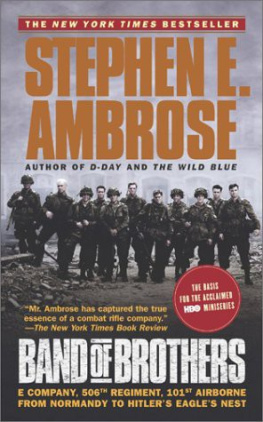LETHAL WARRIORS
WHEN THE NEW BAND OF BROTHERS CAME HOME
DAVID PHILIPPS

The author and publisher have provided this e-book to you for your personal use only. You may not make this e-book publicly available in any way. Copyright infringement is against the law. If you believe the copy of this e-book you are reading infringes on the authors copyright, please notify the publisher at: us.macmillanusa.com/piracy.
LETHAL WARRIORS
Copyright David Philipps, 2010.
All rights reserved.
For information, address St. Martins Press, 175 Fifth Avenue, New York, N.Y. 10010.
First published in 2010 by PALGRAVE MACMILLAN in the United Statesa division of St. Martins Press LLC, 175 Fifth Avenue, New York, NY 10010.
ISBN: 978-0-230-10440-2
Our eBooks may be purchased in bulk for promotional, educational, or business use. Please contact the Macmillan Corporate and Premium Sales Department at 1-800-221-7945, ext. 5442, or by e-mail at .
Library of Congress Cataloging-in-Publication Data
Philipps, David.
Lethal warriors : when the new band of brothers came home / David Philipps.
p. cm.
ISBN 978-0-230-10440-2 (hardback)
1. Post-traumatic stress disorder. 2. Iraq War, 2003VeteransMental health. 3. United States. Army. Parachute Infantry Regiment, 506th. I. Title.
RC552.P67P545 2010
616.85212dc22
2010028192
A catalogue record of the book is available from the British Library.
Design by Letra Libre
First edition: November 2010
10 9 8 7 6 5 4 3 2 1
Printed in the United States of America.
To Amanda
This book is to be neither an accusation nor a confession. It will try simply to tell of a generation of men who, even though they may have escaped its shells, were destroyed by the war.
Erich Maria Remarque,
All Quiet on the Western Front,
1929
ACKNOWLEDGMENTS
This book would not have happened without the gracious help of many people. Thank you, first and foremost, to the soldiers of the Lethal Warriors/Band of Brothers, both named and unnamed, who helped explain what happened even if they would have rather it be forgotten.
At the Colorado Springs Gazette, thanks to Joanna Bean, a good friend and a great editor, and Tom Roeder and Dennis Huspeni, whose reporting laid the foundation for mine. And thanks to editor Jeff Thomas and publisher Steve Pope for having the guts to publish the articles that later grew into this book.
Thanks to my agent, Will Lippincott and my editor, Alessandra Bastagli, who both saw the growing importance of this issue and championed the book. And thanks to all the people at Palgrave Macmillan who helped make it a reality.
Thanks to Mark and Carol Graham for all you have done.
Thanks to the Colorado Springs Police Department, especially Derek Graham, Joe Matiatos, and Brad Pratt. Nice work fellas.
Thanks to the Colorado Public Defenders, especially Sheilagh McAteer.
Thank you mom, for always being willing to read copy.
Thank you Whitman for reminding me that the world is wonderful, and most of all, thank you Amanda, the earth under my feet and the stars over my head. I love you.
INTRODUCTION
A man delivering newspapers found Kevin Shieldss body.
It was 5:00 A.M. Saturday, December 1, 2007four years, seven months, and eleven days after the start of the Iraq War. The deliveryman was rolling in his Ford pickup through a century-old neighborhood packed with crooked bungalows on the west side of Colorado Springs. The block was dark. The sky was clear. Bare branches hung over the predawn street like a black net swimming with stars. The thermometer stood at 14 degrees and the still air had painted frost on the rows of parked cars. Most of the sprawling city of 600,000 on the high, dry prairie at the foot of the Rockies was still asleep. The jagged silhouette of the mountains on the western edge of town stood cloaked in darkness except for a single light shining from the very summit of 14,000-foot Pikes Peak. The quiet yards reeled past the pickups open window, one after another, and the soft thud of copies of the Colorado Springs Gazette falling on the sidewalks and porches sounded the peaceful cadence of the start of another day.
Then there was the body.
The deliveryman pressed on the brakes, a newspaper still in his hand, shoved the shifter into park, and craned out the window for a closer look.
Kevin Shields was sprawled faceup across the sidewalk, his head near the gutter, just inches from the pickups front tire. He looked young, maybe twenty years old, was clean shaven with smooth boyish cheeks, had a military buzz cut, and was wearing no hat or gloves despite the cold. His half-open eyes stared blankly at the net of stars. His feet almost touched a white picket fence hung with red ribbon for Christmas. His head was tilted slightly downhill and blood spilling from his nose and mouth had trickled back and pooled around his eyes, drying in the perfect shape of a mask. A barely smoked Camel lay on his chest where it had landed after falling from his lips.
Hey, buddy! You OK? the deliveryman shouted.
Kevin Shields did not answer.
A bullet had punched a small hole through his right cheek, right where a beauty mark might be. It had splintered the thin shell of his skull and torn apart his temporal lobethe part of the brain that attaches meaning to complex, nuanced images like black branches lacing the night sky or red bows on a white picket fence. A second bullet had pierced his neck, jabbing up through his skull and destroying the part of his cerebellum that acts as the internal metronome bringing balance, time, and space together. A third shot through his tongue and throat before clipping his spinal cord. A fourth tore through the blood-rich muscles of his left thigh.
Kevin Shields was dead.
The deliveryman dropped the rolled-up copy of that days Gazette, fumbled for his cell, and dialed 911.
The paper that hit the pavement not far from Shieldss body that morning held a grab bag of news typical of any city of 600,000: TEACHER CUTS HAIR FOR CHARITY, BUDGET CUTS WORRY EMERGENCY OFFICIALS, MOUNTAINS MAY GET FOUR FEET OF SNOW. But tucked away on page three was news unique to Colorado Springs: BRIGADE LIKELY WILL BE HOME BY CHRISTMAS.
Colorado Springs is perhaps the most military city in America. Take away the backdrop of the Rocky Mountains and in many ways Colorado Springs appears to be any modern western American city, punctuated by inoffensive earth-toned suburban sprawl. The town regularly racks up best city awards from glossy magazines. Most residents are transplants attracted by good jobs, low crime, clean air, and sunshine. Roots are shallow. History is short. There is no regional accent, cuisine, or industry. The biggest nongovernmental employer is Wal-Mart. Neighborhoods are often distinguishable only by the neon clusters of chain stores and restaurants. It could be Mesa, Arizona, or Santa Ana, California, or Salt Lake City, Utah. In many ways, the defining culture is a lack of a defining culture.
At the same time, Colorado Springs is far from typical because it is surrounded by military bases. To the north is the U.S. Air Force Academy, where elite cadets train to be pilots and officers. To the east is Schriever Air Force Base, where pilots who wear jumpsuits but almost never leave the ground control a shadowy armada of military satellites and drones. To the west, burrowed more than a thousand feet into the solid granite of Cheyenne Mountain, is NORAD, where Cold Warera computers scan every inch of earths orbit for incoming nuclear missiles. And to the south sits Fort Carson, the third-largest army base in the country. Around the cluster of military installations swirl an orbit of defense











